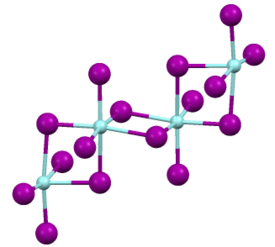Zirconium tetraiodide
 |
|
| Names | |
|---|---|
| Other names
zirconium tetraiodide
|
|
| Identifiers | |
|
3D model (JSmol)
|
|
| ChemSpider | |
| ECHA InfoCard | 100.034.332 |
|
|
|
|
| Properties | |
| ZrI4 | |
| Molar mass | 598.842 g/mol |
| Appearance | orange-yellow crystalline hygroscopic |
| Density | 4.914 g/cm3 |
| Melting point | 499 °C (930 °F; 772 K) (triple point) |
| Boiling point | 431 °C (808 °F; 704 K) (sublimes) |
| Structure | |
| Monoclinic, mP30 | |
| P2/c, No. 13 | |
| Hazards | |
|
EU classification (DSD) (outdated)
|
not listed |
| NFPA 704 | |
| Related compounds | |
|
Other anions
|
Zirconium(IV) fluoride Zirconium(IV) chloride Zirconium(IV) bromide |
|
Other cations
|
Titanium tetraiodide Hafnium tetraiodide |
|
Except where otherwise noted, data are given for materials in their standard state (at 25 °C [77 °F], 100 kPa).
|
|
|
|
|
| Infobox references | |
Zirconium(IV) iodide is the chemical compound with the formula ZrI4. It is the most readily available iodide of zirconium. It is an orange-coloured solid that degrades in the presence of water.The compound was once prominent as an intermediate in the purification of zirconium metal.
Like most binary metal halides, it adopts a polymeric structure. As characterized by X-ray crystallography, the compound exists as a polymer consisting of octahedral Zr(IV) centers, each with a pair of terminal iodide ligands and a four doubly bridging iodide ligands. The Zr-I distances of 2.692 (terminal) and 3.030 Å
This compound is volatile, subliming as intact tetrahedral ZrI4 molecules. It is prepared by the direct reaction of powdered zirconium metal and iodine.
Pyrolysis of zirconium(IV) iodide gas by contact of hot wire was the first industrial process for the commercial production of pure ductile metallic zirconium. This crystal bar process was developed by Anton Eduard van Arkel and Jan Hendrik de Boer in 1925.
...
Wikipedia

